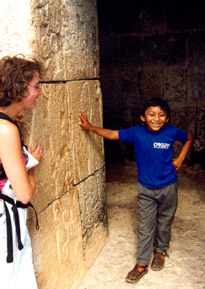|
In Explanation of SELT (1997) English and Ethnography in Pisté
By Dr. Joy Logan
Spanish Division of Languages and Literatures
of Europe and the Americas
University of Hawai'i Manoa
SELT Director, 1997
The School of Experimental Language Training was
experimental in both its theorization and application in the sense that
it evolved out of the grafting of current trends in Second Language
(L2) Acquisition to the theory and practice of experimental ethnography
as it is being developed by Abdel Hernández and Quetzil Castañeda.
Preliminary Considerations
This is the standard definition or description that I have come to give
those who ask about what was involved in setting up the English program
in Pisté in conjunction with the training of student teachers
and student ethnographers. Yet in describing SELT in this manner I am
simplifying and negating the complex, dynamic, and sometimes conflictive
coupling of L2 pedagogy with cultural anthropology that engendered this
experimental language program. Furthermore, I fear that in some ways
this definition draws our focus to the progenitors and the progeny when
the functioning of SELT urged us also always to consider the copulative,
procreative capacities and possibilities of interdisciplinary joinings.
As tempting as it may be to depict and understand SELT as the product
of disciplinary miscegenation, this kind of explanation is reductive.
Representing SELT cannot just be about the outlining of the traits and
characteristics of the engenderers and the engendered, more importantly
it should and must highlight the feel and movement of the engendering
itself. So, even as I offer the definition given above as a point of
departure to discuss the ramifications, consequences, theory, and practice
of SELT, I would warn of its shortcomings and also challenge its reliability
to adequately portray the process of what we in The 1997 Field School
in Experimental Ethnography and the students from Pisté came
to know as School of Experimental Language Training.
Part of the difficulty in defining SELT is that its experimentality
cannot and should not be explained as the material result/conclusion
of an operation which correlates in some manner to criteria projected
by a pre-set hypothesis. Instead, SELT grew out of a spontaneous, intuitive,
hybrid methodology that was constantly modified, on a daily basis, by
a re-working, a re-defining, a re-assessing of its very being and practice.
In proposing spontaneity and intuition as important methodological resources
in formulating SELT I would like to point out that I am not using these
terms as euphemisms for chaos, disorganization, or confusion, but rather
as descriptors that highlight the imaginative and creative forces needed
to support a methodology that was eclectic, multiple, contradictory
and constantly in flux. Nor do these “fuzzy” descriptors
in any way suggest a lack of guidelines, conceptualizations, or presuppositions
in the planning and execution of SELT, rather for us they served as
reminders of our dual intent to plan and implement a language program
based on the needs and desires of the families of Pisté and to
use that space for the practice of experimental ethnography. In essence,
our fundamental task was to look for complementary L2 methods that would
precipitate and support the kind of “transculturative” space
that experimental ethnography also pretends to provoke. Not only did
this require us to use our prior understanding of critical pedagogical
theory, the principles of experimental ethnography, and actual experience
in the classroom, it forced us to invoke those less-than-scientific
and usually immeasurable factors called imagination, intuition, creativity,
and spontaneity in mixing and matching L2 and ethnographical discourses
to turn them into viable SELT strategies.
Within current thinking about second-language acquisition this hybrid
process through which SELT evolved might best be understood through
contemporary ideas on humanistic and holistic pedagogical approaches,
on the one hand, and on the other, through recent theorization in cross-cultural
pragmatics about power and authority in the classroom. I suggest this
theoretical framing only as a point of reference for considering the
structuring of SELT and how our intentions often paralleled key premises
of these two fields of study. It was our intent in SELT to support and
provide a more dialogic learning atmosphere in order to focus on interpersonal,
cultural, and linguistic connections. It was our intent to provoke and
document the reciprocity and multiplicity of transculturation, to reveal
the movement of intercultural contact whose flow is ALWAYS multi-directional
but whose impetus can be obscured or seemingly reduced to uni-directional
by the dominant voice and presence of the anthropologist, specialist,
teacher, or so-called expert. The intent of SELT was also always to
focus on the nature of intent itself, to juxtapose intent with goal,
to self-consciously allow freedom for development and mutation instead
of purposefully channeling the current of classroom interaction into
pre-established ends. If I have reiterated intent it is because the
subtle difference that lies between intent and goal was an essential
concept for the envisioning and execution of SELT. It is the point of
departure from which the critical and practical variations of our EFL
classroom were derived, that is, the point of contrast between a flexible,
generative process and a predetermined course of study. In SELT it was
key for us to remember every day that our only real goal was our intent
to maintain a participatory and open-ended curriculum in both content
and activities.
|




